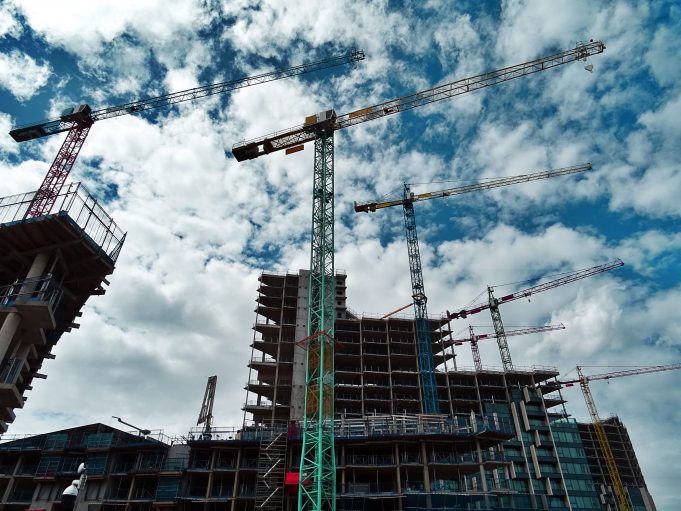There’s no industry that hasn’t been impacted by the Covid-19 crisis. In the construction industry, the impact has been complex, presenting project managers with a wide range of challenges. The global construction industry has faced supply-chain issues, a slow-down in planning and inspection timetables and new measures to ensure the health and safety of the workforce. It’s an unprecedented situation, that has impacted business and family life, with construction workers themselves often facing real difficulties securing continuity of employment.
Construction is the top sector for emergency loans
According to data revealed by the British Business Bank , the construction industry has taken on more emergency loans than any other industry. Building firms have taken out over 218,000 loans across the Coronavirus Business Interruption Loan and Bounce Back Loan Schemes, with the motor industry in second place. By value, first and second place is reversed, with construction borrowing £7.93bn of loans, behind the motor industry with £9.56bn of loans.
The data doesn’t reveal how many of the loans have actually been used, with some industry experts stating that many building firms are securing loans while they are still available as a contingency should cashflow conditions worsen further.
These loans may yet be vital in ensuring that projects are completed, and a skilled workforce is maintained.
Difficult times
There’s no escaping from the fact that 2020 has been an unexpectedly difficult period for the construction industry. There has been a 35% drop in construction productivity since the pandemic began, a decrease that puts it on a par with a severe recession. This isn’t expected to abate overnight, as cases again begin to rise and a return to normality now not looking likely until Spring 2021. The Construction Product Association is warning about significant drops in construction activity well into 2021, with a revival in activity not taking place until the second half of the year.
Working through the pandemic
With no immediate end in sight, as much building work as possible needs to continue through the pandemic. Construction is one of the major drivers of economic growth, so it’s vital that work can continue as safely as possible.
The government have issued a range of guidelines for working outdoors that now apply to the construction sector. These were formulated with the input of the Health & Safety Executive, industry bodies, Public Health England, and unions.
These include a wide range of advice and guidelines including:
- Social distancing – workers should be 2m apart where possible, or at least 1m apart if not.
- Proper risk assessments according to the Health & Safety guidelines.
- Good communication strategies between employers and the workforce, regular conversations about what’s happening, and how the guidelines are being enacted.
- Staggered worker arrival and break times.
- The creation of one-way systems on site.
- Anyone who feels ill, has a cough or temperature should not enter the site.
- Increase in hand washing, sanitising and surface cleaning.
- Using the same driver for all deliveries to minimise contact and infection work.
- Wherever possible, people should be able to work from home.
- Face-to-face meetings should be limited to ten people and held outside if the conditions allow.
- Breaks should be taken outside, weather permitting.
- Specific employees should be partnered to work in groups, to limit the amount of people who regularly interact.
- Back-to-back and side-to-side working should be encouraged, rather than face-to-face.
All of these, and other measures can be helpful in reducing the transmission of the virus and lowering risk, while allowing for projects to continue. The implementation of these guidelines depends on the result of a project’s particular risk analysis. Workers alongside each other inside a house reaching completion will face a different set of risks to those tiling the roof, for instance.
By improving communication channels, and by encouraging more socially distanced team meetings where it’s safe to do so, it’s hoped that a team ethos to tackle the issues raised can be fostered. Beating the virus and carrying on working can then be seen as a shared endeavour. At the end of the pandemic, many construction companies hope to be able to look back with a sense of pride at how they adapted and played their part in beating the virus, while maintaining economic activity.
Embracing digital solutions
Constructions leaders have been quick to embrace digital solutions to some of the challenges the industry is currently facing. Cloud software has been embraced, helping to drive greater efficiency and collaboration between staff. This has helped to facilitate real-time working between on-site project managers and colleagues who are working from home. There is some evidence that not only has this allowed work to continue on some projects that would otherwise have been postponed, it’s also aided greater efficiency than was expected. This has now resulted in a growing number of construction companies saying that they now intend to permanently support remote working for some of their staff.
The pandemic has sped up the digital transformation project across the construction industry. By drawing on e-sourcing and digital stock management systems, construction companies have been able to streamline stock and procurement processes during the lockdown
Other digital innovations include virtual site visits to reduce the on-site footfall, and incorporating technology into protective equipment such as hard hats featuring smart technology that gives real time information about risk and feedback.
Adapting to new opportunities
The Covid-19 pandemic has presented a set of serious challenges to the construction industry, but in adapting to those challenges, new better ways of working are beginning to emerge.
At Goodmix Concrete, we’re proud to say that we’ve kept operating throughout the crisis and adapted where necessary to keep our clients and staff safe.
With many people forced to retrain and seek new employment, the construction industry will want to offer opportunities for people to retrain and develop a new career.
As the world emerges from the current emergency, the construction industry will be well placed to take advantage of any bounce back as a result of pent-up demand.














